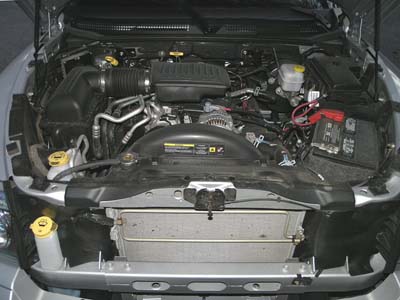Everything about Dodge trucks is large. In fact, everything coming out of the Chrysler Corporation side of Daimler Chrysler sports huge grilles that I for one don’t think are attractive. To me the sedan grilles are too large and the trucks are almost ridiculous. But that opinion was forged before I saw and drove the Dodge Dakota.

Yes, the Dakota’s grille is huge, the more to draw huge amounts of air into its 4.7-liter V8 engine I suppose. With edgier styling around the fenders and that chrome-lines grille, the “face” of the Dakota doesn’t seem that disproportioned. And since you can’t see it from inside the truck, it really isn’t that bad.
 Our tester was the Quad Cab version of the Dakota, with two full-size doors to provide access to the rear seats. Technically, the Quad Cab offers seating for six passengers. Rear seat passengers have about the same amount of legroom they’d find in the new Durango SUV, which isn’t bad. Front seat passenger room is enormous, which is most important since the front seats are the ones that will be used most often.
Our tester was the Quad Cab version of the Dakota, with two full-size doors to provide access to the rear seats. Technically, the Quad Cab offers seating for six passengers. Rear seat passengers have about the same amount of legroom they’d find in the new Durango SUV, which isn’t bad. Front seat passenger room is enormous, which is most important since the front seats are the ones that will be used most often.
Behind the Quad Cab is a 5.3-foot bed, which is long enough for most loads. Of course, there’s always that standard 4×8 sheet of plywood measurement, but if you’re carrying plywood home from The Home Depot, you can tie it down and travel with the tailgate lowered.
 2006 Hyundai Azera InteriorWith a redesign for 2005, the Dakota is built on the same wheelbase but is four inches longer and more than 600 pounds heavier than its predecessor. That’s the large part I was talking about. Dakota is a compact pickup with full-size pretensions. This is a plus for owners who don’t use their trucks for work, because the economy is better. Dakota is available in Quad Cab and Club Cab (with rear “access doors”). The regular cab model is not offered.
2006 Hyundai Azera InteriorWith a redesign for 2005, the Dakota is built on the same wheelbase but is four inches longer and more than 600 pounds heavier than its predecessor. That’s the large part I was talking about. Dakota is a compact pickup with full-size pretensions. This is a plus for owners who don’t use their trucks for work, because the economy is better. Dakota is available in Quad Cab and Club Cab (with rear “access doors”). The regular cab model is not offered.
Performance with the 4.7-liter V8 engine was very good. We tested the Dakota on our favorite hillclimb and it performed as well as most of the sedans we’ve tried. Also, handling was very good for a truck. In rear-wheel drive mode it was possible to spin the rear tires and in some cases lose traction. The week we drove the car it was first rainy and then snowy and icy. There was one day when we didn’t drive the Dakota because our driveway had more than four inches of snow on it and I didn’t want to pack it down before shoveling. Eventually we turned the 4WD on and had better traction in snow, but yucky performance on dry roads.
 The Dakota’s 4WD system is not meant for dry roads. Nor is it meant for normal day-to-day driving. When it’s engaged, it’s almost impossible to make a tight turn on dry pavement. Also, steering effort is increased in reverse, which can be a problem when parking. But it’s not meant for dry pavement and is meant for snow and off-road conditions.
The Dakota’s 4WD system is not meant for dry roads. Nor is it meant for normal day-to-day driving. When it’s engaged, it’s almost impossible to make a tight turn on dry pavement. Also, steering effort is increased in reverse, which can be a problem when parking. But it’s not meant for dry pavement and is meant for snow and off-road conditions.
The V8 engine is relatively quiet under most driving conditions. Wind noise is also missing most of the time, which shows that Dodge did a good job in silencing the inside of the cab.
2006 Hyundai Azera EngineOur tester had complete instrumentation. We also had 12-volt power outlets in the dash and in the center console.
My wife loved the heated seats (a $250 option), which seemed to warm up faster than some others we’ve tried.
The audio system was an AM/FM stereo radio with a 6-CD in-dash changer that could handle MP3 discs. Audio controls were on the steering wheel and were located in such a way so as not to be accidentally moved when driving.

Our tester had a trailer tow accessory group ($525) that included a n oil cooler, class IV hitch, and wiring harness. Four-wheel disc brakes (two-wheel are standard) added another $495. The standard engine is a 3.7-liter V6; the V8 added $795. We also had supplemental side air bags and side curtain air bags ($495), chrome wheels ($595), and a box bedliner ($245), as well as Sirius satellite radio ($195).
All in all, the Dakota had a bottom line of $33,609 from a base price of $28,679. It’s expensive, and it’s large for a “compact” pickup, but with the V8 engine and 4×4 it has enormous capabilities.
Any information provided on this Website is for informational purposes only and is not intended to replace consultation with a professional mechanic. The accuracy and timeliness of the information may change from the time of publication.
















